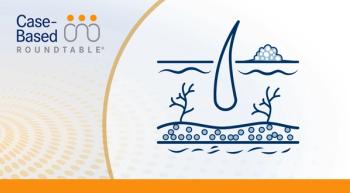
Dabrafenib Plus Trametinib Shows Improved Survival in Phase II Trial for BRAF V600 Melanoma
Treatment with dabrafenib (Tafinlar) plus trametinib (Mekinist) resulted in a complete response in 9 of 19 patients with stage IIIb/c BRAF V600 melanoma, according to results from a phase II trial presented at the 2016 ASCO Annual Meeting.
Robyn P.M. Saw, MD
Treatment with dabrafenib (Tafinlar) plus trametinib (Mekinist) resulted in a complete response (CR) in 9 of 19 patients with stage IIIb/c BRAF V600 melanoma, according to results from a phase II trial presented at the 2016 ASCO Annual Meeting.
The combination of dabrafenib plus trametinib has previously been shown to improve the overall survival (OS) of patients withBRAFV600 mutation-positive advanced melanoma. This small Australian study examined how the combined regimen performed in patients with histologically confirmed bulky resectable stage III melanoma.
Lead author Robyn P.M. Saw, MD, associate professor of surgery at the University of Sydney and a surgical oncologist at Melanoma Institute Australia, was pleased with the results. “It’s encouraging that no patient progressed during neoadjuvant therapy and that nearly half the patients experienced a complete response,” she said.
The study’s primary objectives were to determine how many patients had a pathological CR at 12 weeks postoperatively and to assess the RECIST response rate at 12 weeks. Secondary endpoints included surgical morbidity, relapse-free survival, OS, toxicity, pyrexia frequency, and correlation of biomarkers with clinical endpoints for translational research.
Of the patient pool (n=19), 18 (95%) had theBRAFV600E mutation, while 1 (5%) had theBRAFV600K mutation.
Following a baseline biopsy and initial CT and PET scans, patients received dabrafenib (150 mg BID) plus trametinib (2 mg once daily). Tumors were biopsied again after one week of treatment. At 12 weeks patients received CT and PET scans and their pre-therapy tumor beds were completely resected. They then received 40 additional weeks of the combined regimen. CT monitoring was continued every 12 weeks thereafter to 2 years and then every 6 months to 3 years.
The combined regimen was fairly well tolerated. All 19 patients were able to complete 12 weeks of neoadjuvant therapy. Between 3 months and a year, 5 patients discontinued therapy. Of these, 2 patients discontinued the study due to pyrexia/pyrexia syndrome, and 1 each due to acute renal failure, recurrence, and radiotherapy.
The recurrence rates were notable: no patients showed recurrent disease during the 12 weeks of neoadjuvant therapy. Only 3 patients (16%) experienced recurrence following resection (between weeks 12 and 52) and no patients’ disease recurred after 52 weeks or going off-therapy. Of the patients who showed recurrent disease on therapy, 1 (5%) had local disease and 2 (11%) experienced distant disease.
Only 1 patient (5%) died during the study period. This patient was the sole study participant with aBRAFV600K mutation. Pathologically, this patient had a non-complete response (nCR). The patient had a partial RECIST response (rPR) and stable disease measured metabolically.
Of the remaining 18 patients, 9 (47%) had a pathological CR (pCR); 9 (47%) had a complete RECIST response (rCR) and 10 (52%) had a metabolic CR (mCR). “Most patients with pathological complete response also had both RECIST and metabolic complete responses,” noted Dr. Saw.
As of late May 2016, the median follow-up was 11.2 months. The shortest follow-up was 4 months; the longest, 21 months.
Among the adverse events, pyrexia was common, and was experienced by 15 patients (79%). At less than 12 weeks, 17 patients (89%) had pyrexia or pyrexia syndrome, defined as a syndrome of chills or sweats, associated with headache, nausea, fatigue, hypotension, neutropenia, hepatitis, or raised CRP levels. After 12 weeks, the pyrexia rate had decreased slightly to 13 patients (68%). Ten patients (53%) received corticosteroids prophylactically for pyrexia or pyrexia syndrome, and 17 (89%) experienced treatment interruption due to pyrexia or pyrexia syndrome.
The most significant surgical outcome was improved operability in 13 patients (68%). Other notable outcomes: 6 patients (32%) experienced wound infection requiring antibiotics, 2 patients (11%) had bleeding, 6 patients (32%) had seromas that required intervention, and 5 patients (26%) showed new or worsening lymphedema.
Associated translational studies that occurred as a result of the trial included in-depth immune profiling of both blood and tumor tissue. Blood plasma studies were performed involving cytokines and circulating DNA; for peripheral blood mononuclear cells, cytokines and immunophenotype. Fresh tumor tests included melanoma- and tumor-associated fibroblast cell lines, tumor-infiltrating lymphocytes, cytokines, and mass cytometry. Fresh frozen tests examined IHC, DNA, RNA, and proteins.
The study concluded that dabrafenib plus trametinib yielded a pCR for 9 patients (47%); all but 1 patient with pCR also had mCR and rCR. No patients progressed during neoadjuvant therapy. Only 2 patients (11%) had elevated circulating free DNA at baseline; these patients experienced recurrence prior to 52 weeks. Surgical complication rates were as expected, and frequent pyrexia required treatment interruption and prophylactic corticosteroids.
Saw R, Menzies AM, Guminski A, et al. Phase 2 study of neoadjuvant dabrafenib + trametinib (D+T) for resectable stage IIIB/C BRAF-V600 mutation positive melanoma.J Clin Oncol34, 2016 (suppl; abstr 9583).













































